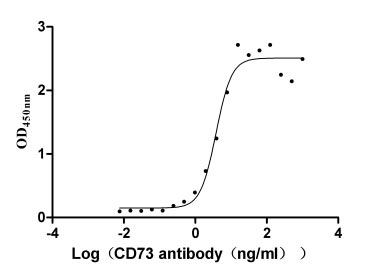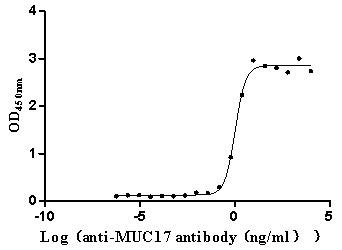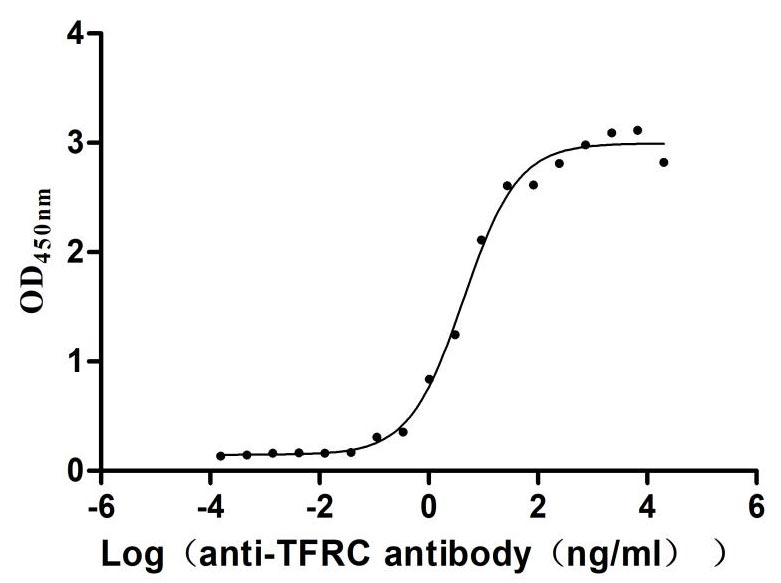Recombinant Mouse Parvalbumin alpha (Pvalb)
-
货号:CSB-YP019092MO
-
规格:
-
来源:Yeast
-
其他:
-
货号:CSB-EP019092MO-B
-
规格:
-
来源:E.coli
-
共轭:Avi-tag Biotinylated
E. coli biotin ligase (BirA) is highly specific in covalently attaching biotin to the 15 amino acid AviTag peptide. This recombinant protein was biotinylated in vivo by AviTag-BirA technology, which method is BriA catalyzes amide linkage between the biotin and the specific lysine of the AviTag.
-
其他:
-
货号:CSB-BP019092MO
-
规格:
-
来源:Baculovirus
-
其他:
-
货号:CSB-MP019092MO
-
规格:
-
来源:Mammalian cell
-
其他:
产品详情
-
纯度:>85% (SDS-PAGE)
-
基因名:
-
Uniprot No.:
-
别名:Pvalb; Pva; Parvalbumin alpha
-
种属:Mus musculus (Mouse)
-
蛋白长度:Full Length of Mature Protein
-
表达区域:2-110
-
氨基酸序列SMTDVLSAE DIKKAIGAFA AADSFDHKKF FQMVGLKKKN PDEVKKVFHI LDKDKSGFIE EDELGSILKG FSSDARDLSA KETKTLLAAG DKDGDGKIGV EEFSTLVAES
-
蛋白标签:Tag type will be determined during the manufacturing process.
The tag type will be determined during production process. If you have specified tag type, please tell us and we will develop the specified tag preferentially. -
产品提供形式:Lyophilized powder
Note: We will preferentially ship the format that we have in stock, however, if you have any special requirement for the format, please remark your requirement when placing the order, we will prepare according to your demand. -
复溶:We recommend that this vial be briefly centrifuged prior to opening to bring the contents to the bottom. Please reconstitute protein in deionized sterile water to a concentration of 0.1-1.0 mg/mL.We recommend to add 5-50% of glycerol (final concentration) and aliquot for long-term storage at -20℃/-80℃. Our default final concentration of glycerol is 50%. Customers could use it as reference.
-
储存条件:Store at -20°C/-80°C upon receipt, aliquoting is necessary for mutiple use. Avoid repeated freeze-thaw cycles.
-
保质期:The shelf life is related to many factors, storage state, buffer ingredients, storage temperature and the stability of the protein itself.
Generally, the shelf life of liquid form is 6 months at -20°C/-80°C. The shelf life of lyophilized form is 12 months at -20°C/-80°C. -
货期:Delivery time may differ from different purchasing way or location, please kindly consult your local distributors for specific delivery time.Note: All of our proteins are default shipped with normal blue ice packs, if you request to ship with dry ice, please communicate with us in advance and extra fees will be charged.
-
注意事项:Repeated freezing and thawing is not recommended. Store working aliquots at 4°C for up to one week.
-
Datasheet :Please contact us to get it.
相关产品
靶点详情
-
功能:In muscle, parvalbumin is thought to be involved in relaxation after contraction. It binds two calcium ions.
-
基因功能参考文献:
- Data indicate that fast-spiking interneurons which typically express parvalbumin (PV) show greater firing coherence with CA1 network oscillations. PMID: 28382952
- Martinotti cells in layers II/III of the mouse primary somatosensory cortex are inhibited by both parvalbumin (PV)- and vasoactive intestinal polypeptide (VIP)-expressing cells. PMID: 27897179
- Synapses from parvalbumin-expressing interneurons onto hippocampal pyramidal neurons are regulated by neuronal firing, signaling through L-type calcium channels. PMID: 29295931
- This study investigated the distribution of Ca2+-binding proteins (CaBPs), such as calbindin D28k, parvalbumin, and calretinin, in the Superior Olivary Complex of the circling mouse on postnatal day 16. PMID: 29130968
- Axotomy Leads to Reduced Calcium Increase and Upregulated Parvalbumin Followed by Decreased Neighboring Microglial Activation. PMID: 28017131
- reduction of PV(+) neurons was in all cases, i.e., in PV+/-, Shank1-/- and Shank3B-/- mice, was due to a reduction in Pvalb mRNA and PV protein PMID: 26819149
- The calcium-binding protein parvalbumin (PV) is a crucial marker in defining the most predominant interneuron subtype within the cerebral cortex. PMID: 26882036
- dysfunction of parvalbumin positive interneurons signaling in the prefrontal cortex (PFC) specifically produces deficits in the cognitive domain, but does not give rise to PFC-dependent correlates of negative or positive symptoms. PMID: 26608841
- Thus PV+ GP neurons are synaptically positioned to directly coordinate activity between BG input nuclei, the striatum and STN, and thalamic-output from the SNr. PMID: 26905595
- These findings confirm that fate determination of cortical interneurons subgroups is crucially influenced by Shh signaling, and provide a system for the further study of interneuron fate and function. PMID: 25804737
- Parvalbumin and Npas1 neurons have different topologies within the basal ganglia. PMID: 26311767
- Nearly all parvalbumin interneurons express Lynx1 did not detect Lypd6 in this population. Conversely, in somatostatin interneurons Lypd6 was found in a subset localized to deep cortical layers but no somatostatin neurons show detectable levels of Lynx1. PMID: 25359633
- Our data indicate that the injury-triggered up-regulation of PV-expression is mediated by inflammatory cytokines, and promotes the motility and adhesion of ependymal cells. PMID: 25421913
- There was a significant correlation between Y-maze performance and PV expression in the dorsal hippocampus in WT mice, but no such correlation in BDNF+/- mice. PMID: 25603414
- EF-hand Ca(2+) buffers regulate presynaptic IHC function for metabolically efficient sound coding. PMID: 25691754
- Fgfr1 inactivation in the mouse telencephalon results in impaired maturation of interneurons expressing parvalbumin. PMID: 25116473
- This study demonistrated that Early- and late-born parvalbumin basket cell subpopulations exhibiting distinct regulation and roles in learning. PMID: 25695271
- Impaired excitability of somatostatin- and parvalbumin-expressing cortical interneurons in a mouse model of Dravet syndrome. PMID: 25024183
- This study demonistrated that the developmental trajectory of parvalbumin- and calretinin-positive interneurons along the dorso-ventral and rostro-caudal axes of the ventral hippocampus in juvenile, adolescent, and adult rats. PMID: 23893875
- Suppression of excitatory parvalbumin-positive fast spiking interneurons in the prelimbic area may enhance reward-related behavioral flexibility. PMID: 24599468
- Parvalbumin tunes spike-timing and efferent short-term plasticity in striatal fast spiking interneurons. PMID: 23551945
- The results of this study suggested a niche mechanism involving parvalbumin interneurons that couples local circuit activity to the diametric regulation of two critical early phases of adult hippocampal neurogenesis. PMID: 24212671
- This study demonistrated that Parvalbumin-expressing inhibitory interneurons in auditory cortex are well-tuned for frequency in mice. PMID: 23966693
- These results suggest the fact that the maintenance of parvalbumin expression is mediated to the neuroprotective function of nicotinamide against ischemic brain injury. PMID: 23047329
- We failed to provide proof-of-concept evidence that lower PV and GAT1 expression in schizophrenia are a consequence of lower GAD67 expression PMID: 23103418
- The rapid spiking inhibitory interneurons that co-express PV are involved in shaping neural responses to fast spectrotemporal modulations. We examined cortical PV expression in the C57bl/6 mouse, a strain commonly studied as a presbycusis model. PMID: 23010334
- In a circling mouse model of deafness, there is a decrese in expression of parvalbumin in the hippocampus. PMID: 22226504
- Increase in NF-kappaB activation coincides with increased reactive oxygen species production and decreased parvalbumin expression in parvalbumin-interneurons in vitro. PMID: 21378588
- The results of this study indicated that PV cells are ideally suited to modulate cortical gain and establish a causal relationship between a select neuron type and specific computations performed by the cortex during sensory PMID: 22243754
- phenotype of mice with GABA(A) receptor gamma2 subunits from parvalbumin neurons PMID: 21912668
- Our work indicates that parvalbumin and the cannabinoid-1 (CB1) receptor might be far more intricately related than previously thought. PMID: 21445945
- The relative mean density of calbindin and parvalbumin immunoreactivity in the Purkinje cell layer is significantly decreased in the homozygous cir/cir genotype, compared with the wild-type. PMID: 20691752
- Data show that parvalbumin-positive interneurons are dispensable for spatial reference, but are essential for spatial working memory. PMID: 21278730
- These data provide more direct evidence of the protective role of parvalbumin against the degeneration mediated by a calcium increase in the acute injury of motor neurons. PMID: 20394052
- Data conclude that GPx4 is a selenoenzyme modulating interneuron function and parvalbumin expression. PMID: 19890015
- The expression of PV and its colocalization with neuronal nitric oxide synthase have been determined in different populations of hippocampal GABAergic neurons. PMID: 12115690
- Parvalbumin deficiency, due to an increased short-term facilitation of GABA release, enhances inhibition by high-frequency burst-firing PV-expressing interneurons and may affect the higher cognitive functions associated with gamma oscillations. PMID: 12626620
- The slight aggravation of muscle dystrophy observed in mdx mice deprived of parvalbumin cannot explain the severity of the affection observed in xmd dogs and Duchenne dystrophy patients where parvalbumin is constitutively not expressed. PMID: 12798793
- Distinct kinetics of parvalbumin and calbindin D28k underlie biphasic kinetics of synaptically evoked Ca2+ transients in dendritic shafts of Purkinje cells. PMID: 12813159
- This study conclude that alterations in the Ca(2+) homeostasis present in mice ectopically expressing neuronal PV are more deleterious under excitotoxic stress PMID: 14980812
- Parvalbumin arises as a major contributor to presynaptic Ca(i) signals and synaptic integration in the cerebellar cortex. PMID: 15634771
- Retinal illumination had opposite effects on levels of parvalbumin and oxytocin and decreased parvalbumin staining in the cilia. PMID: 15964694
- These results demonstrate that the absence of the parvalbumin disrupts the regulation of Purkinje cell firing rate and rhythmicity. PMID: 16115209
- Quantitative analysis of selected mitochondrial proteins revealed the PV-/- tibialis anterior mitochondria composition to be almost identical to that in wild-type soleus, but not in wild-type fast-twitch muscles. PMID: 16367751
- Density of parvalbumin-positive neurons does not alter during cortical plasticity in classical conditioning. PMID: 16413119
- Calcium-binding proteins may contribute to selective vulnerability and an early loss of function of large motor neurons in this SOD1-transgenic mouse model. PMID: 16546142
- In-strain embryo transfer had a differential influence on the numbers of amygdaloid parvalbumin-immunoreactive neurons of inbred C3H/HeN and DBA/2J mice. Maternal factors had a some impact on the numbers of PARV-ir neurons. PMID: 16860404
- The firing properties of four subtypes of parvalbumin-positive interneurons allow the neuron networks to perform an array of information-processing tasks within the basolateral amygdala. PMID: 17234587
- Analysis revealed a slightly increased activity in mice lacking parvalbumin as well as an increase in the characteristic speed during the first 8 day. PMID: 17275105
- Our results indicate that CB, PV and GABA show a dynamic pattern of colocalization in cells of the mouse basolateral amygdalar nucleus throughout development. PMID: 17681450
显示更多
收起更多
-
蛋白家族:Parvalbumin family
-
数据库链接:
KEGG: mmu:19293
STRING: 10090.ENSMUSP00000005860
UniGene: Mm.2766
Most popular with customers
-
Recombinant Human 5'-nucleotidase (NT5E) (Active)
Express system: Mammalian cell
Species: Homo sapiens (Human)
-
Recombinant Human Poliovirus receptor (PVR) (I340M), partial (Active)
Express system: Mammalian cell
Species: Homo sapiens (Human)
-
Recombinant Human Cytokine receptor common subunit beta (CSF2RB), partial (Active)
Express system: Mammalian cell
Species: Homo sapiens (Human)
-
Recombinant Human Mucin-17 (MUC17), partial (Active)
Express system: Mammalian cell
Species: Homo sapiens (Human)
-
Recombinant Human Glucagon-like peptide 1 receptor (GLP1R), partial (Active)
Express system: Mammalian cell
Species: Homo sapiens (Human)
-
Recombinant Human Transferrin receptor protein 1 (TFRC), partial (Active)
Express system: Mammalian cell
Species: Homo sapiens (Human)
-
Recombinant Human Serine/threonine-protein kinase receptor R3 (ACVRL1), partial (Active)
Express system: Baculovirus
Species: Homo sapiens (Human)
-
Recombinant Human Myosin regulatory light chain 12A (MYL12A) (Active)
Express system: E.coli
Species: Homo sapiens (Human)



-AC1.jpg)
















